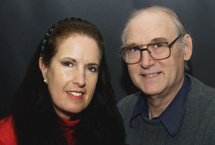 Photo gurus Daniel Grotta and Sally Wiener Grotta (photographed to the right) are widely respected photography and imaging experts. They run The Photo Gurus Radio Show and are well known for their down-to-earth, easy-to understand approach to fun and creative photography. In their show from August 08, 2008, they talked about The Imaging Source astronomy cameras.
Photo gurus Daniel Grotta and Sally Wiener Grotta (photographed to the right) are widely respected photography and imaging experts. They run The Photo Gurus Radio Show and are well known for their down-to-earth, easy-to understand approach to fun and creative photography. In their show from August 08, 2008, they talked about The Imaging Source astronomy cameras.
You can download the show as an MP3 file.
The part, where they are talking about our astronomy cameras is between 02:00 and 04:07.
Below is a transcript of what they say:
Sally: On a very different note, here up in the mountains, we have an incredible view of the Milky Way. When you read about the various comets, that you can not see in the city, we eyeball them from our field. But I have never tried to photography any of it, except the Moon, of course.
Daniel: Well, we do not have a telescope!
Sally: Well, yes - not yet. That is on our wish list! But the problem with photography is that there is not enough light from the stars, the comets, the planets. And that means if I wanted to photograph it, I would have to use a very long time exposure.
Daniel: And as you know, the longer time exposure you have, the more noise it produces.
Sally: Poor image quality all around. You can keep your lens wide open and then you get all kind of light, so you do not get any dark. It just does not work. Now, [The] Imaging Source has announced some new cameras - we have not tested them - but they sound really neat. They are for amateur astronomy buffs. Daniel, you have the details on them, right:
Daniel: Yes. First of all, the cameras are only for telescopes. You cannot use them for shooting the kids in the park. They are small, light-weight, boxed sized in shape devices that you put into a telescope standard C-mount thread. The devices are build around low noise Sony CCD sensors and they allow long exposures - up to sixty minutes. Or very short sequential bursts, as fast as sixty frames per second. The software controls all the parameters, such as the exposure time, sensitivity and frame rate. And depending upon the model, they are priced between USD 350 and USD 850, it records either color or monochrome, it features either a USB or FireWire interface and it is available in a variety of resolutions. You can get further information about [The] Imaging Source's cameras at www.astronomycamera.com.
Sally: So, if I get you one of these cameras, you will get me telescope, Daniel.
Daniel: Well.
A great thanks goes out to Daniel Grotta and Sally Wiener Grotta for talking about The Imaging Source astronomy cameras.